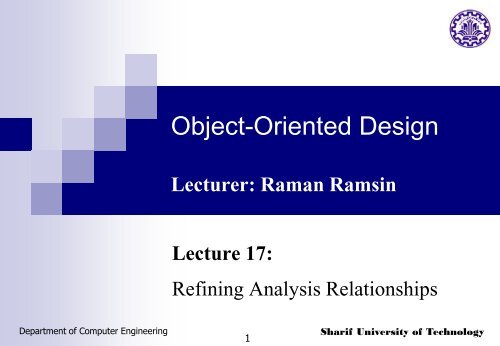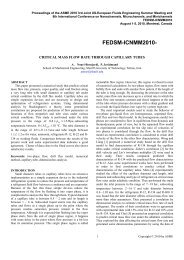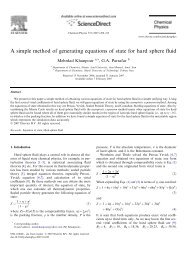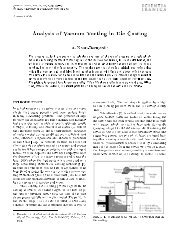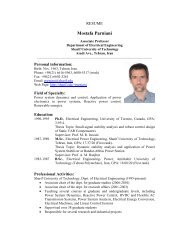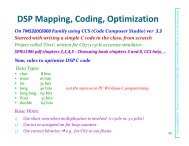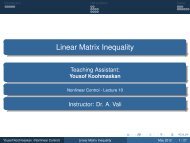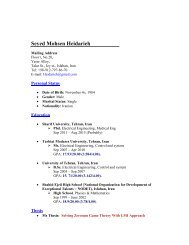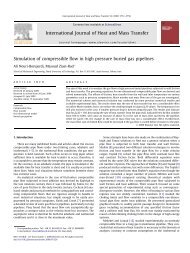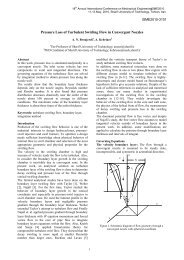Refining Analysis Relationships
Refining Analysis Relationships
Refining Analysis Relationships
- No tags were found...
Create successful ePaper yourself
Turn your PDF publications into a flip-book with our unique Google optimized e-Paper software.
Object-Oriented Design – Lecture 17Aggregation Relationship• Whole-part relationship where objects of one class act as the wholeor aggregate, and objects of the other class act as the parts;general semantics: Assembly, Containment, or Membership; can beused in analysis as well as design;the whole uses the services of the parts; the parts service therequests of the whole;the whole is the dominant, controlling side of the relationship; thepart tends to be more passive;aggregation is transitive: If C is part of B and B is part of A, then Cis part of A.Department of Computer Engineering3Sharif University of Technology
Object-Oriented Design – Lecture 17Aggregation Relationship: Asymmetry• Aggregation relationship is asymmetric:a whole can never directly or indirectly be a part of itself;there must never be a cycle in the aggregation graph.Department of Computer Engineering4Sharif University of Technology
Object-Oriented Design – Lecture 17<strong>Refining</strong> <strong>Analysis</strong> <strong>Relationships</strong>: One-to-One Association• Add navigability to the model; refine into Composition only if the semanticsapply; you may also choose to merge the two classes.Department of Computer Engineering8Sharif University of Technology
Object-Oriented Design – Lecture 17<strong>Refining</strong> <strong>Analysis</strong> <strong>Relationships</strong>: Many-to-One Association• Add navigability; refine into Aggregation only if the semantics apply.Department of Computer Engineering9Sharif University of Technology
Object-Oriented Design – Lecture 17<strong>Refining</strong> <strong>Analysis</strong> <strong>Relationships</strong>: One-to-Many Association• There is a collection of objects on the target side: Use an inbuilt array (most OO languages directly support arrays) -they are generally quite inflexible but are usually fast.Use a collection class - they are more flexible than inbuilt arrays andare faster than arrays when searching the collection is required(otherwise they are slower).Department of Computer Engineering10Sharif University of Technology
Object-Oriented Design – Lecture 17Collections• Classes specialized so that their instances canmanage a collection of other objects.• All collection classes have operations for: adding objects to the collection; removing objects from the collection; retrieving a reference to an object in the collection; traversing the collection - stepping through the collectionfrom the first object to the last.Department of Computer Engineering11Sharif University of Technology
Object-Oriented Design – Lecture 17Modeling with Collections• There are four options:1. model the collection class explicitly;Department of Computer Engineering12Sharif University of Technology
Object-Oriented Design – Lecture 17Modeling with Collections• There are four options:1. model the collection class explicitly;2. tell the modeling tool which collection to use by adding aproperty to the relationship;Department of Computer Engineering13Sharif University of Technology
Object-Oriented Design – Lecture 17Modeling with Collections• There are four options:1. model the collection class explicitly;2. tell the modeling tool which collection to use by adding aproperty to the relationship;3. tell the programmer what collection semantics arerequired by adding a property to the relationship;Department of Computer Engineering14Sharif University of Technology
Object-Oriented Design – Lecture 17Modeling with Collections• There are four options:1. model the collection class explicitly;2. tell the modeling tool which collection to use by adding aproperty to the relationship;3. tell the programmer what collection semantics arerequired by adding a property to the relationship;Department of Computer Engineering15Sharif University of Technology
Object-Oriented Design – Lecture 17Modeling with Collections• There are four options:1. model the collection class explicitly;2. tell the modeling tool which collection to use by adding aproperty to the relationship;3. tell the programmer what collection semantics arerequired by adding a property to the relationship;Department of Computer Engineering16Sharif University of Technology
Object-Oriented Design – Lecture 17Modeling with Collections• There are four options:1. model the collection class explicitly;2. tell the modeling tool which collection to use by adding aproperty to the relationship;3. tell the programmer what collection semantics arerequired by adding a property to the relationship;4. instead of refining one-to-many relationships to collectionclasses, leave it up to the programmers.• Don't "overmodel" - the choice of a specific collection class isoften a tactical issue that can be left to the programmer atimplementation time.Department of Computer Engineering17Sharif University of Technology
Object-Oriented Design – Lecture 17Modeling with Collections: The Map• Also known as the dictionary;• Given a key, the corresponding value may be found very quickly;• Acts like a database table with two columns, the key and the value;• Keys must be unique.Department of Computer Engineering18Sharif University of Technology
Object-Oriented Design – Lecture 17Reifying <strong>Analysis</strong> <strong>Relationships</strong>• Some relationships are pure analysis artifacts andmust be made implementable by the process ofreification:1. Many-to-many associations2. Bidirectional associations3. Association classesDepartment of Computer Engineering19Sharif University of Technology
Object-Oriented Design – Lecture 17Reifying <strong>Relationships</strong>: Many-to-Many Associations1. Reify the relationship into a class.2. Add navigability; Refine into Aggregation or Composition onlyif the semantics apply.Department of Computer Engineering20Sharif University of Technology
Object-Oriented Design – Lecture 17Reifying <strong>Relationships</strong>: Bidirectional Associations• Replace with two unidirectional associations or a reified class;refine into Aggregation or Composition only if the semanticsapply.Department of Computer Engineering21Sharif University of Technology
Object-Oriented Design – Lecture 17Reifying <strong>Relationships</strong>: Association Classes1. Replace with a class (usually with the same name as the association class);2. Add a constraint in a note to indicate that objects on each end of the reifiedrelationship must form a unique pair.Department of Computer Engineering22Sharif University of Technology
Object-Oriented Design – Lecture 17Structured Classifier• A classifier (such as a class) that has an internal structure.• Modeled as parts that are joined with connectors:part - a role that one or more instances of a classifier can play in thecontext of the structured classifier;name - the name of the part;type - the type of objects that can play the role;multiplicity - the number of objects that can play the role at anytime;connector - a relationship between parts in the context of astructured classifier.Department of Computer Engineering23Sharif University of Technology
Object-Oriented Design – Lecture 17Structured Classifier: NotationDepartment of Computer Engineering24Sharif University of Technology
Object-Oriented Design – Lecture 17Structured Class• A class that has an internal structure;• Has the extra constraint that it owns (has an implicit containmentrelationship with) all of its parts, connectors, and ports.Department of Computer Engineering25Sharif University of Technology
Object-Oriented Design – Lecture 17Structured Class: Modeling• Internal structure can be shown on class diagrams or on acomposite structure diagram.Department of Computer Engineering26Sharif University of Technology
Object-Oriented Design – Lecture 17Reference• Arlow, J., Neustadt, I., UML 2 and the Unified Process: PracticalObject-Oriented <strong>Analysis</strong> and Design, 2 nd Ed. Addison-Wesley,2005.Department of Computer Engineering27Sharif University of Technology


